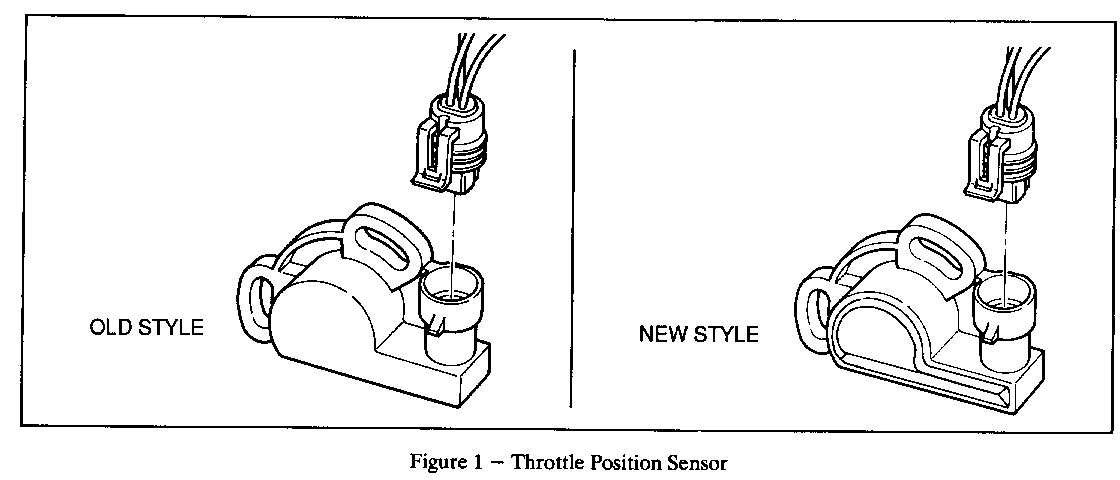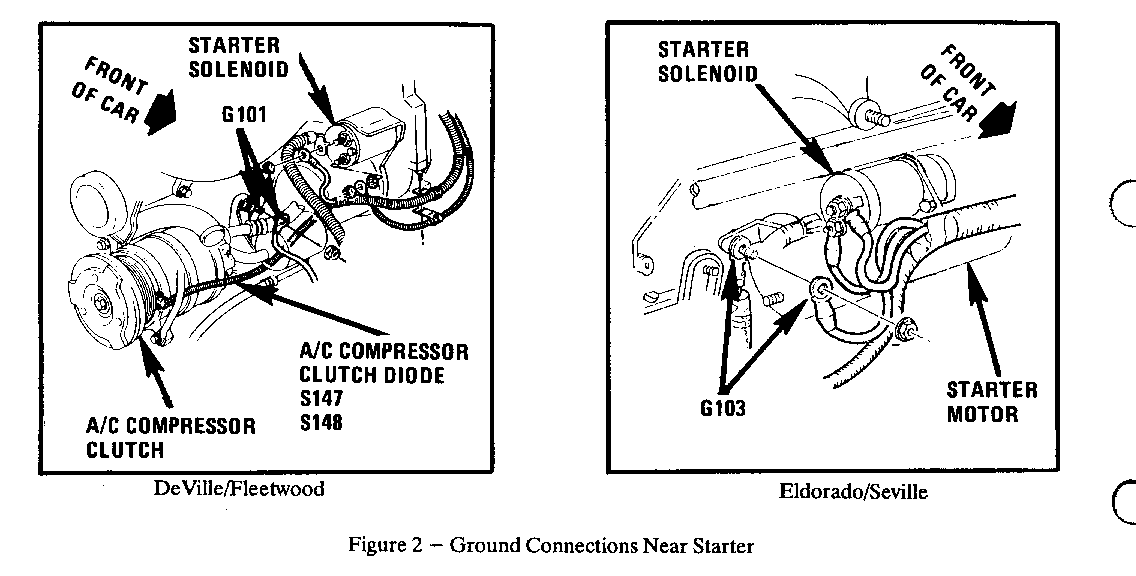STALL AFTER COLD START; ENG. STALL ON COAST DOWN

SUBJECT: INTERMITTENT STALL AFTER START COLD; ENGINE STALLING ON COAST DOWN; HESITATION COLD; OR ECM CODES E22, E26, E32, E55, E70, AND/OR E85
MODELS AFFECTED: 1990-1992 DE VILLES, FLEETWOODS, ELDORADOS, AND SEVILLES
This bulletin has been revised to update the repair procedures and warranty statement. This bulletin replaces T-92-87, Group 6E, which should be discarded.
Some 1990-1992 DeVilles, Fleetwoods, Eldorados, and Sevilles may experience an intermittent stall after start cold, stall on coast down with an immediate restart, or cold engine hesitation. This condition may be accompanied by an ECM code E22, E26, E32, E55, E70, or E85. This may be caused by an erratic signal from the Throttle Position Sensor (TPS), a poor ground connection near the starter, and/or PCM PROM calibration.
To repair this condition use the following procedure:
1. For 1990-1991 vehicles only, visually inspect the TPS. If the TPS is the old style, replace it with P/N 17112609 (Figure 1). Refer to Section 6E-C2 of the appropriate Service information Manual for correct replacement and adjustment procedures.
2. Relocate ground connection near starter (Figure 2) as follows:
a. Remove the starter bracket mounting bolt to the block, the nut that secures the starter bracket to the starter, and the starter bracket.
b. Discard the starter bracket and the starter bracket mounting bolt to the block.
c. On DeVilles and Fleetwoods only, remove the ground cable located at the motor mount (G101).
d. Clean both the ring terminal and the engine block in the area where the starter bracket was located with a wire brush.
e. Using a new starter bracket, P/N 3538914, bend the starter bracket as necessary to provide clearance between the block and the bracket for the ring terminal.
f. Install the starter bracket with the ring terminal between the block and the bracket.
g. Install a new starter bracket mounting stud to the block, P/N 3537885. Torque to 38 Nm (27 lbs. ft.).
h. Reinstall the nut that secures the starter bracket to the starter. Torque to 3.0 Nm (27 lbs. in.).
3. On 1991 and 1992 vehicles only, check the PCM PROM I.D. using on-board diagnostics. If the PROM I.D. in the vehicle is lower than the indicated service PROM I.D. in the following chart, replace the PROM with the indicated part number.
Service Service Emission PROM Broadcast Service Vehicle Year System I.D. Code P/N ------- ---- -------- ------- --------- ------- DeVille Coupe, DeVille 1991-1992 Fed. 417 BBXF 16180314 Sedan, Fleetwood Coupe
DeVille Coupe, DeVille 1991-1992 Cal. 418 BBXH 16180315 Sedan, Fleetwood Coupe
Fleetwood Sedan, 60 1991-1992 Fed. 421 BBXL 16180320 Special, Funeral Coach
Fleetwood Sedan, 60 1991-1992 Cal. 419 BBXJ 16180317 Special
C - Touring Sedan 1991-1992 Fed. 416 BBXC 16180312
C - Touring Sedan 1991 Cal. 416 BBXC 16180312
C - Touring Sedan 1992 Cal. 415 BBXB 16180310
C - Heavy Duty Chassis 1991-1992 Fed./Cal. 420 BBXK 16180318
E/K 1991 Fed. 1065 BBWW 16180302
E/K 1991 Cal. 1066 BBWX 16180303
E/K 1992 Fed. 1068 BBWZ 16180307
E/K 1992 Cal. 1069 BBXA 16180308
ETC/STS 1991 Fed./Cal. 1067 BBWY 16180304
ETC/STS 1992 Fed./Cal. 1070 BBXD 16180313
Parts are currently available from GMSPO.
4. Clean carbon deposits from the throttle blades and bores using a soft bristle brush (i.e., toothbrush) and GM top engine cleaner, P/N 1052626, or A/C-Delco carburetor tune-up conditioner, P/N X66-P, or equivalent.
IMPORTANT: Do not use any solvent that contains methyl ethyl ketone.
5. Check and adjust minimum air rate and Throttle Position Sensor (TPS) settings using procedures in the appropriate Service Information Manual.
6. Perform TPS and idle learn Procedure:
NOTE: Do not touch the accelerator pedal or steering wheel during the TPS and idle learn procedure. Make sure the outside air temperature reading is at least 50 degrees Fahrenheit.
o Inspect throttle linkage for any signs of binding or improper cruise control cable adjustment.
Ensure the accelerator pedal is free and clear.
o Ensure the minimum air rpm is set at 500 rpm on vehicles with less than 500 miles or 525 rpm on vehicles with more than 500 miles.
o Turn ignition on, enter diagnostics and wait for code display to begin, turn ignition off, and wait 20 seconds.
o Turn ignition on, enter diagnostics and wait for code display to begin, turn ignition off, and wait 20 seconds.
o Turn ignition on, enter diagnostics and wait for code display to begin, turn ignition off, and wait 20 seconds.
o On 1990 vehicles, run the engine continuously for 18 minutes (under any operating conditions).
o On 1991 and 1992 vehicles, run the engine continuously for 13 minutes (under any operating conditions).
o Apply brake and shift transaxle into Drive.
o Place the Electronic Climate Control in the OFF position and allow engine to idle for one minute.
o Make sure the outside air temperature reading is at least 50 degrees Fahrenheit.
o Place the Electronic Climate Control in the AUTO position, select HIGH blower, verify A/C clutch engagement by listening for A/C clutch "click" under hood, and allow engine to idle for one minute.
o Place transaxle in Park and turn ignition off.
IMPORTANT: Because of the load differences on the engine with A/C on versus A/C off, idle learning must be completed under both conditions.
7. If the above steps do not correct the stalling or hesitation problem, continue diagnosis using the appropriate Service Information Manual procedures.
WARRANTY INFORMATION
Operation Description Operation Number VEHICLE SERIES --------------------- ---------------- -------------- C D E K V ------------------------- Engine Stalling on Coast T6527 1.3 1.5 1.5 Down and/or ECM Codes E22, E26, E32, E55, E70, or E85 Includes: Minimum air/TPS adjustment and TPS/idle learn procedures.
ADD:
A - To replace TPS .3 .3 .3
B - To replace PROM .4 .4 .4
Policy. E


General Motors bulletins are intended for use by professional technicians, not a "do-it-yourselfer". They are written to inform those technicians of conditions that may occur on some vehicles, or to provide information that could assist in the proper service of a vehicle. Properly trained technicians have the equipment, tools, safety instructions and know-how to do a job properly and safely. If a condition is described, do not assume that the bulletin applies to your vehicle, or that your vehicle will have that condition. See a General Motors dealer servicing your brand of General Motors vehicle for information on whether your vehicle may benefit from the information.
